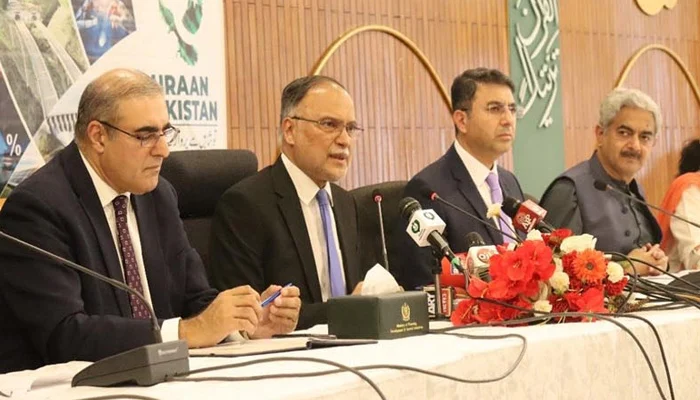Federal Minister for Planning, Development and Special Initiatives Ahsan Iqbal, in highlighting the government’s development priorities, announced that Balochistan has been placed on an accelerated development trajectory, with Rs230 billion allocated in the federal budget 2025-26 for this purpose. Addressing a press conference in Islamabad on Thursday, the minister stated that the development of Balochistan is being treated as a national responsibility, in line with Prime Minister Shehbaz Sharif’s directives.
This initiative aims to fundamentally transform the socio-economic landscape of the province over the next two years through strategic investments in crucial infrastructure projects designed to enhance connectivity. A significant component of this development plan is the N-25 Chaman-Quetta-Karachi highway, for which Rs100 billion has been earmarked. This project is anticipated to be completed within two to three years and will serve as a vital strategic corridor. Additionally, work on the M8 and several other regional infrastructure schemes, intended to boost connectivity, attract investment, and ensure inclusive development, will also be expedited.
Ahsan Iqbal stressed the government’s strong emphasis on the water sector, given increasing global concerns over water as a geopolitical tool. He underscored the urgent need to finalize critical reservoir projects to safeguard Pakistan’s water security. He mentioned India’s attempts to weaponize water, reiterating that while India cannot legally obstruct Pakistan’s water under the Indus Waters Treaty (IWT)—nor will it be permitted to—it may attempt to disrupt flows. To counteract potential threats and ensure long-term resilience, the government is rapidly progressing with the completion of the Diamer Bhasha and Mohmand dams, with storage capacities of 6 million acre-feet and approximately 1 million acre-feet respectively, bringing the total capacity to around 7 million acre-feet.
The minister acknowledged that tight fiscal space, stemming from structural constraints, has curtailed the government’s capacity to finance development projects under the Public Sector Development Programme (PSDP). He noted that the development budget has fallen from 2.6% of GDP in 2017-18 to merely 0.8%—a trend he characterized as a severe structural concern for national development. Moving forward, the government intends to fund development and other expenditures through domestic resources. However, achieving this objective necessitates raising Pakistan’s tax-to-GDP ratio to at least 16%, a level already maintained by regional counterparts.
Discussing the economy’s performance, he attributed the country’s economic turnaround to the bold, politically unpopular decisions taken by the coalition government under Premier Shehbaz’s leadership, aimed at ensuring long-term stability. He recalled that many predicted the PDM government would only last a few weeks upon assuming power. “It was the prime minister’s courageous leadership and tough economic measures that saved Pakistan from collapse,” he asserted, adding that these reforms, though costly in terms of political capital, were indispensable for national interest.
Iqbal highlighted the challenges faced at the outset of the coalition’s tenure, including the devastating 2022 floods which inflicted over $30 billion in damages. “Despite the crisis, we continued development funding—unlike the previous PTI government, which withheld funds for an entire quarter,” he stated, accusing the former ruling party—Pakistan Tehreek-e-Insaf (PTI)—of leaving behind a ballooning trade deficit of $50 billion and engaging in hate-based politics rather than development.
Iqbal pointed to a series of positive economic indicators: inflation reduced to 4%, the policy rate decreased from 23% to 11%, and a thriving stock market. He added that international institutions have recognized Pakistan’s recovery, with global journals referring to it as a “miracle turnaround.” Tax reforms have resulted in a record 29% increase in Federal Board of Revenue (FBR) revenue collection. Development spending also witnessed a sharp rise, with the total outlay increasing by 50% in FY2025-26 to Rs4.224 trillion from Rs2.832 trillion, supported by improved provincial allocations.
Reforms in the energy sector, including the restructuring of subsidies and resolution of issues with Independent Power Producers (IPPs), have enhanced fiscal discipline. The government is now prioritizing sustained growth driven by domestic resources, increased exports, and rising remittances, which have grown from $27 billion to $37 billion. He concluded that the government’s development plan, branded “Uraan Pakistan,” is already yielding results and projects GDP growth to increase from 2.7% to 4.2% in the coming fiscal year. Iqbal emphasized that boosting exports and increasing revenues are crucial for putting Pakistan’s economy on a path of sustainable growth and breaking free from recurrent boom-and-bust cycles.



